ACC321 - Auditing & Professional Practice Assignment 1 Solution 2018
VerifiedAdded on 2023/06/04
|11
|2143
|286
Report
AI Summary
This assignment solution provides a detailed analysis of auditing and professional practice, focusing on Fredgrau Enterprises. It covers audit planning, identification of key accounts, determination of materiality levels, and comparative analysis using trend analysis and common size income statements for 2016 and 2017. The solution includes a preliminary analytical review to determine audit risk and design appropriate audit procedures. It also addresses fraud risk analysis, emphasizing the importance of professional skepticism and adherence to ethical standards like APES 110. Key accounts such as sales, depreciation, and interest are analyzed with specific audit assertions and recommended steps for auditing. The report concludes with recommendations for fraud risk assessment and further examination of accounts like cost of sales and superannuation expenses.
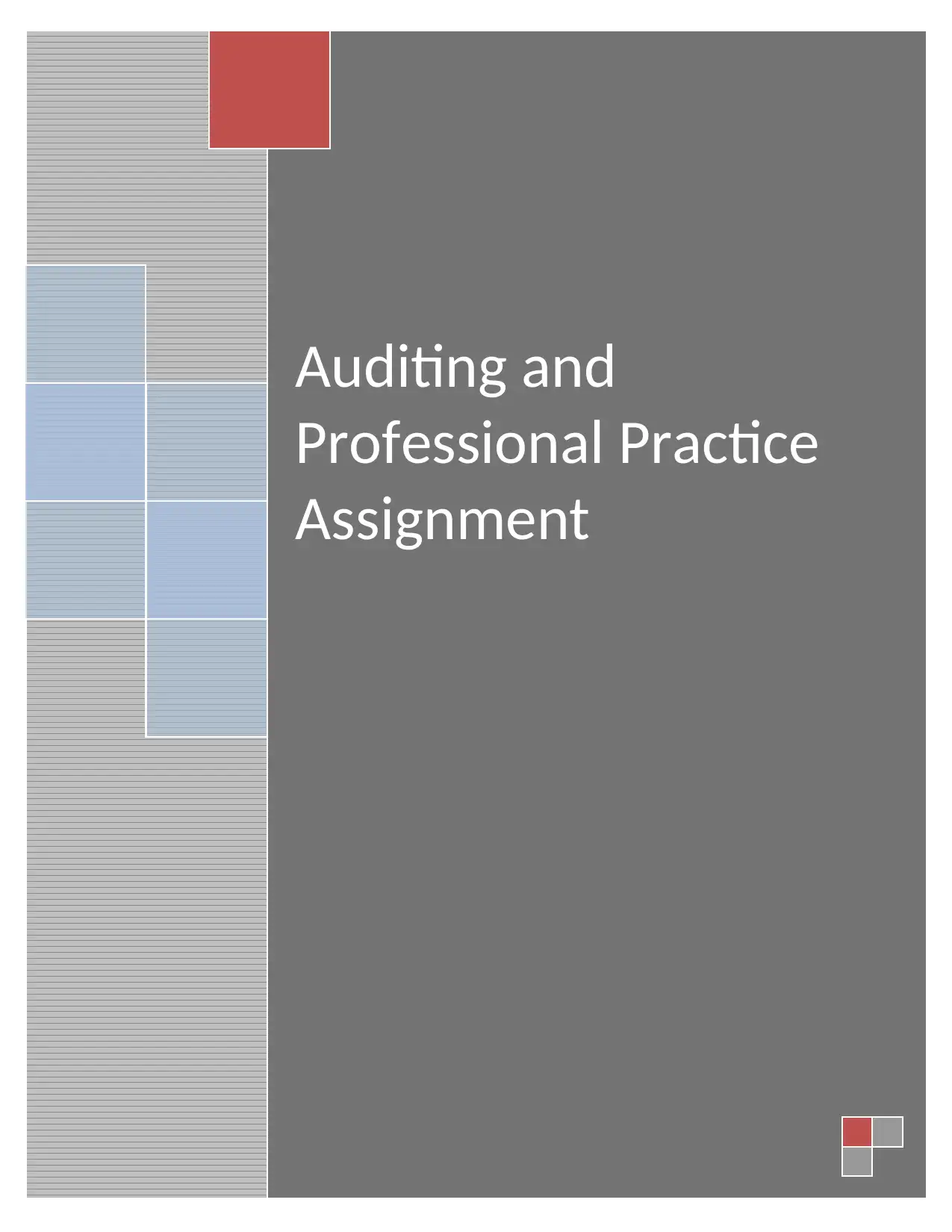
Auditing and
Professional Practice
Assignment
Professional Practice
Assignment
Paraphrase This Document
Need a fresh take? Get an instant paraphrase of this document with our AI Paraphraser

1
By student name
Professor
University
Date: 25 April 2018.
1 | P a g e
By student name
Professor
University
Date: 25 April 2018.
1 | P a g e

2
Contents
Introduction.................................................................................................................................................3
Analysis and Discussion...............................................................................................................................4
Conclusion & Recommendation..................................................................................................................8
References...................................................................................................................................................9
2 | P a g e
Contents
Introduction.................................................................................................................................................3
Analysis and Discussion...............................................................................................................................4
Conclusion & Recommendation..................................................................................................................8
References...................................................................................................................................................9
2 | P a g e
⊘ This is a preview!⊘
Do you want full access?
Subscribe today to unlock all pages.

Trusted by 1+ million students worldwide

3
Introduction
Fredgrau Enterprises is a small company for which the audit planning needs to be done and
therefore the audit partner of the company has asked to the course of action to be taken about the
same. Based on the trial balance given by the company the audit procedure to be taken has been
designed besides identification of the key and critical accounts, which shows the huge deviation
(Axelsen, et al., 2017). Materiality level for the company has also been determined and the
comparative analysis of the company for 2 years 2016 and 2017 has been done via the trend
analysis and the common size income statement. This preliminary analytical review has helped
the company in determining the audit risk and thus audit procedures have been deigned
accordingly. In the end, the fraud risk analysis has also been done for the client to check if it was
a privy to any of the fraud transactions.
3 | P a g e
Introduction
Fredgrau Enterprises is a small company for which the audit planning needs to be done and
therefore the audit partner of the company has asked to the course of action to be taken about the
same. Based on the trial balance given by the company the audit procedure to be taken has been
designed besides identification of the key and critical accounts, which shows the huge deviation
(Axelsen, et al., 2017). Materiality level for the company has also been determined and the
comparative analysis of the company for 2 years 2016 and 2017 has been done via the trend
analysis and the common size income statement. This preliminary analytical review has helped
the company in determining the audit risk and thus audit procedures have been deigned
accordingly. In the end, the fraud risk analysis has also been done for the client to check if it was
a privy to any of the fraud transactions.
3 | P a g e
Paraphrase This Document
Need a fresh take? Get an instant paraphrase of this document with our AI Paraphraser
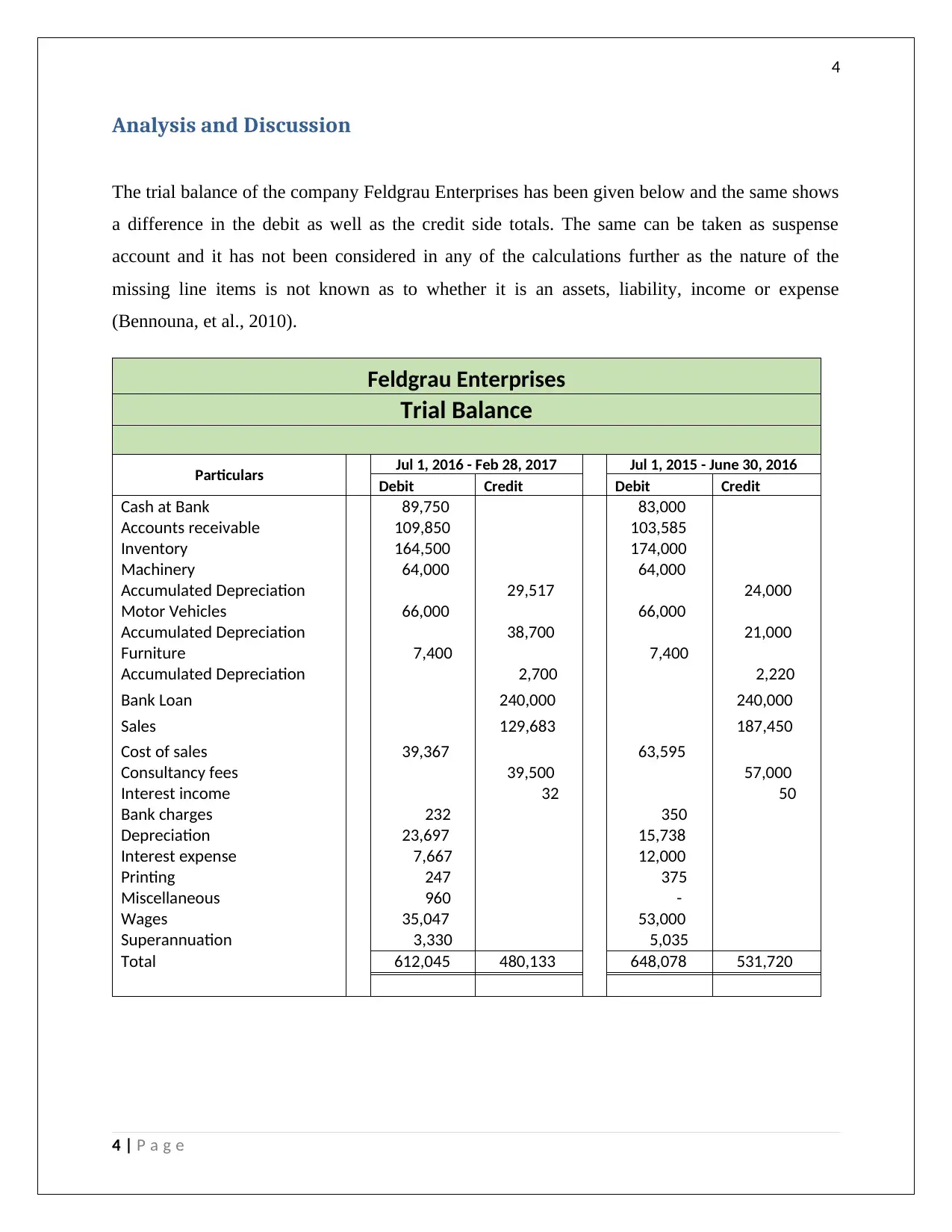
4
Analysis and Discussion
The trial balance of the company Feldgrau Enterprises has been given below and the same shows
a difference in the debit as well as the credit side totals. The same can be taken as suspense
account and it has not been considered in any of the calculations further as the nature of the
missing line items is not known as to whether it is an assets, liability, income or expense
(Bennouna, et al., 2010).
Feldgrau Enterprises
Trial Balance
Particulars Jul 1, 2016 - Feb 28, 2017 Jul 1, 2015 - June 30, 2016
Debit Credit Debit Credit
Cash at Bank 89,750 83,000
Accounts receivable 109,850 103,585
Inventory 164,500 174,000
Machinery 64,000 64,000
Accumulated Depreciation 29,517 24,000
Motor Vehicles 66,000 66,000
Accumulated Depreciation 38,700 21,000
Furniture 7,400 7,400
Accumulated Depreciation 2,700 2,220
Bank Loan 240,000 240,000
Sales 129,683 187,450
Cost of sales 39,367 63,595
Consultancy fees 39,500 57,000
Interest income 32 50
Bank charges 232 350
Depreciation 23,697 15,738
Interest expense 7,667 12,000
Printing 247 375
Miscellaneous 960 -
Wages 35,047 53,000
Superannuation 3,330 5,035
Total 612,045 480,133 648,078 531,720
4 | P a g e
Analysis and Discussion
The trial balance of the company Feldgrau Enterprises has been given below and the same shows
a difference in the debit as well as the credit side totals. The same can be taken as suspense
account and it has not been considered in any of the calculations further as the nature of the
missing line items is not known as to whether it is an assets, liability, income or expense
(Bennouna, et al., 2010).
Feldgrau Enterprises
Trial Balance
Particulars Jul 1, 2016 - Feb 28, 2017 Jul 1, 2015 - June 30, 2016
Debit Credit Debit Credit
Cash at Bank 89,750 83,000
Accounts receivable 109,850 103,585
Inventory 164,500 174,000
Machinery 64,000 64,000
Accumulated Depreciation 29,517 24,000
Motor Vehicles 66,000 66,000
Accumulated Depreciation 38,700 21,000
Furniture 7,400 7,400
Accumulated Depreciation 2,700 2,220
Bank Loan 240,000 240,000
Sales 129,683 187,450
Cost of sales 39,367 63,595
Consultancy fees 39,500 57,000
Interest income 32 50
Bank charges 232 350
Depreciation 23,697 15,738
Interest expense 7,667 12,000
Printing 247 375
Miscellaneous 960 -
Wages 35,047 53,000
Superannuation 3,330 5,035
Total 612,045 480,133 648,078 531,720
4 | P a g e

5
1. Materiality has been asked to be determined in the first part of the audit plan. An item can
be said to be material if it in individual or in aggregate with the similar nature line items
can change the decision of the user of the financial statements. It is something which is
very critical and important to determine from audit perspective as it helps the auditor in
knowing which all areas needs to be checked anyhow and what all areas can be ignored
for the time being (Fukukawa & Mock, 2011). Furthermore, in the given case, the audit
partner has determined the materiality to be at $ 15000, which is very high considering
the trial balance of the client. There are global accounting bodies and committees all over
the world like those of AASB and IASB as well as the reputed audit and consulting firms
like Big 4’s which have suggested that the materiality can be determined as a % of sales,
or Net profit or gross profit or total assets, or total fixed assets balance or as percentage of
shareholder’s equity. Based on these percentages the same has been calculated to be
between the range of $1105 to $ 1296 as it would help the auditors to check several other
accounts as well which were not covered earlier like those of Interest expenses,
superannuation expenses and the Furniture account (Delone & Mclean, 2004).
(in $)
Feldgrau Enterprises
Quantitative estimate of materiality
Criterion Base Amount Materiality level/range
0.5% to 1% of gross revenue Gross Revenue 129,683 648.42 to 1296.83
1% to 2% of the total assets Total Assets 430,582 4305.82 to 8611.64
1% to 2% of the gross profit Gross Profit 55,270 552.7 to 1105.4
2% - 5% of the shareholders’ equity Equity NA NA
5% to 10% of the net profit Net profit 58,670 2933.5 to 5866.99
5 | P a g e
1. Materiality has been asked to be determined in the first part of the audit plan. An item can
be said to be material if it in individual or in aggregate with the similar nature line items
can change the decision of the user of the financial statements. It is something which is
very critical and important to determine from audit perspective as it helps the auditor in
knowing which all areas needs to be checked anyhow and what all areas can be ignored
for the time being (Fukukawa & Mock, 2011). Furthermore, in the given case, the audit
partner has determined the materiality to be at $ 15000, which is very high considering
the trial balance of the client. There are global accounting bodies and committees all over
the world like those of AASB and IASB as well as the reputed audit and consulting firms
like Big 4’s which have suggested that the materiality can be determined as a % of sales,
or Net profit or gross profit or total assets, or total fixed assets balance or as percentage of
shareholder’s equity. Based on these percentages the same has been calculated to be
between the range of $1105 to $ 1296 as it would help the auditors to check several other
accounts as well which were not covered earlier like those of Interest expenses,
superannuation expenses and the Furniture account (Delone & Mclean, 2004).
(in $)
Feldgrau Enterprises
Quantitative estimate of materiality
Criterion Base Amount Materiality level/range
0.5% to 1% of gross revenue Gross Revenue 129,683 648.42 to 1296.83
1% to 2% of the total assets Total Assets 430,582 4305.82 to 8611.64
1% to 2% of the gross profit Gross Profit 55,270 552.7 to 1105.4
2% - 5% of the shareholders’ equity Equity NA NA
5% to 10% of the net profit Net profit 58,670 2933.5 to 5866.99
5 | P a g e
⊘ This is a preview!⊘
Do you want full access?
Subscribe today to unlock all pages.

Trusted by 1+ million students worldwide
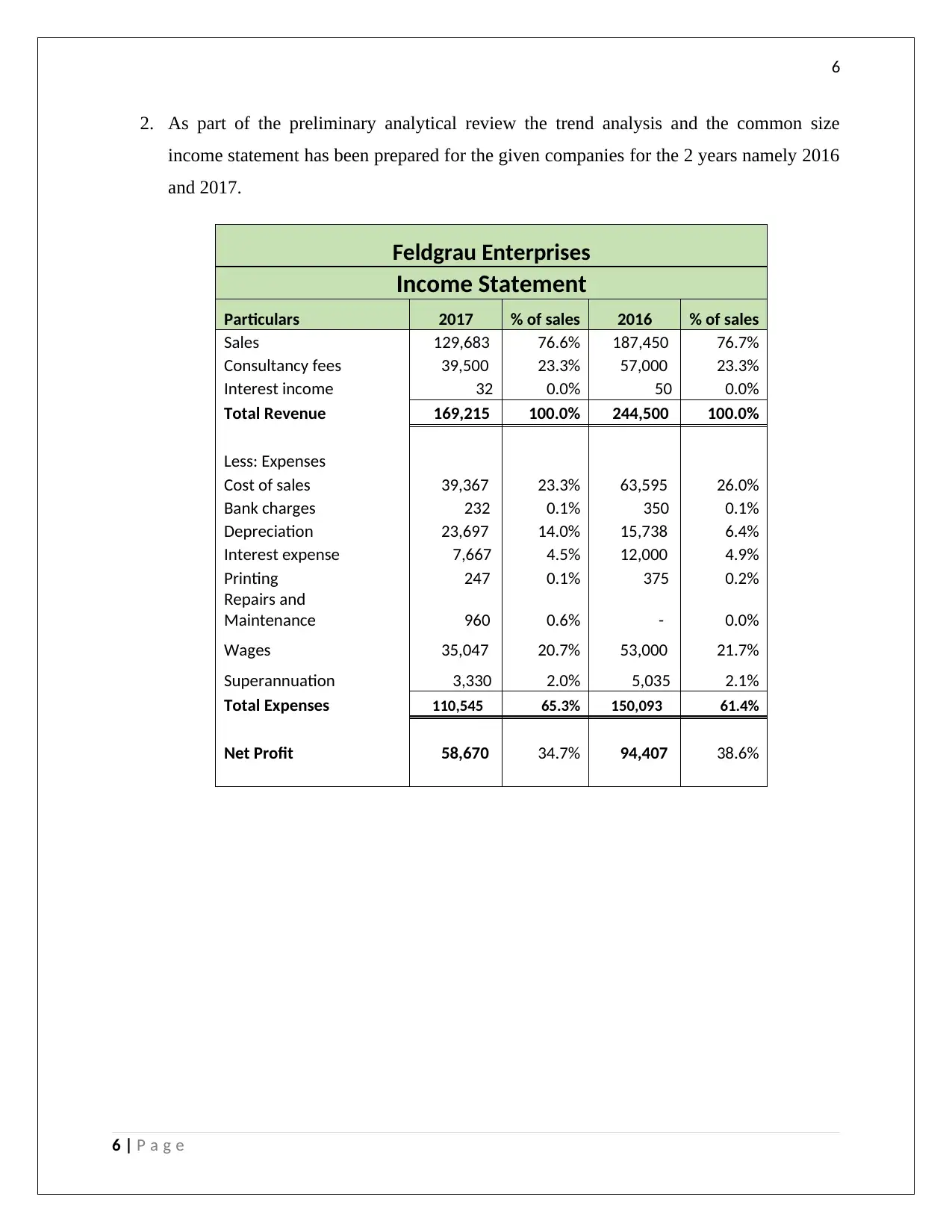
6
2. As part of the preliminary analytical review the trend analysis and the common size
income statement has been prepared for the given companies for the 2 years namely 2016
and 2017.
Feldgrau Enterprises
Income Statement
Particulars 2017 % of sales 2016 % of sales
Sales 129,683 76.6% 187,450 76.7%
Consultancy fees 39,500 23.3% 57,000 23.3%
Interest income 32 0.0% 50 0.0%
Total Revenue 169,215 100.0% 244,500 100.0%
Less: Expenses
Cost of sales 39,367 23.3% 63,595 26.0%
Bank charges 232 0.1% 350 0.1%
Depreciation 23,697 14.0% 15,738 6.4%
Interest expense 7,667 4.5% 12,000 4.9%
Printing 247 0.1% 375 0.2%
Repairs and
Maintenance 960 0.6% - 0.0%
Wages 35,047 20.7% 53,000 21.7%
Superannuation 3,330 2.0% 5,035 2.1%
Total Expenses 110,545 65.3% 150,093 61.4%
Net Profit 58,670 34.7% 94,407 38.6%
6 | P a g e
2. As part of the preliminary analytical review the trend analysis and the common size
income statement has been prepared for the given companies for the 2 years namely 2016
and 2017.
Feldgrau Enterprises
Income Statement
Particulars 2017 % of sales 2016 % of sales
Sales 129,683 76.6% 187,450 76.7%
Consultancy fees 39,500 23.3% 57,000 23.3%
Interest income 32 0.0% 50 0.0%
Total Revenue 169,215 100.0% 244,500 100.0%
Less: Expenses
Cost of sales 39,367 23.3% 63,595 26.0%
Bank charges 232 0.1% 350 0.1%
Depreciation 23,697 14.0% 15,738 6.4%
Interest expense 7,667 4.5% 12,000 4.9%
Printing 247 0.1% 375 0.2%
Repairs and
Maintenance 960 0.6% - 0.0%
Wages 35,047 20.7% 53,000 21.7%
Superannuation 3,330 2.0% 5,035 2.1%
Total Expenses 110,545 65.3% 150,093 61.4%
Net Profit 58,670 34.7% 94,407 38.6%
6 | P a g e
Paraphrase This Document
Need a fresh take? Get an instant paraphrase of this document with our AI Paraphraser
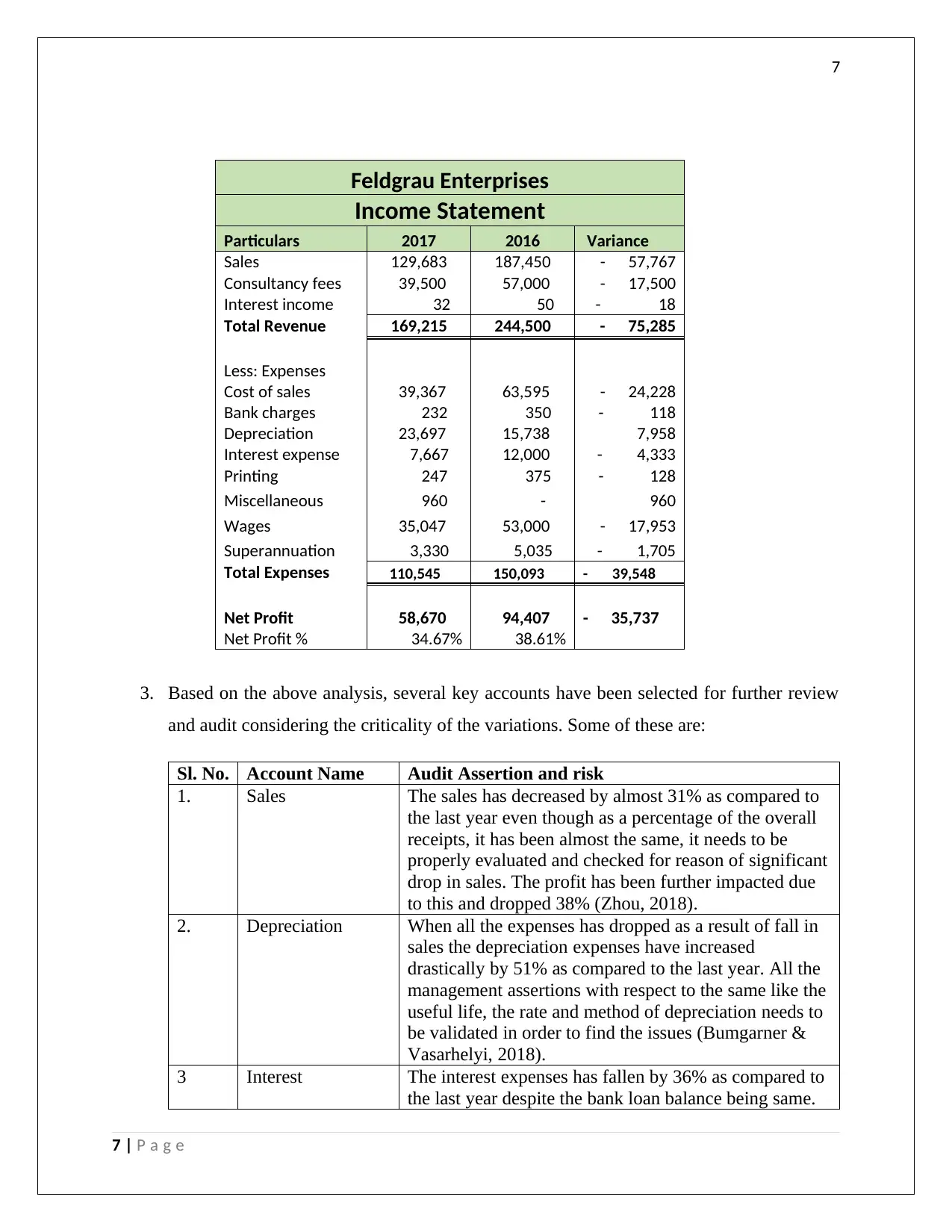
7
Feldgrau Enterprises
Income Statement
Particulars 2017 2016 Variance
Sales 129,683 187,450 - 57,767
Consultancy fees 39,500 57,000 - 17,500
Interest income 32 50 - 18
Total Revenue 169,215 244,500 - 75,285
Less: Expenses
Cost of sales 39,367 63,595 - 24,228
Bank charges 232 350 - 118
Depreciation 23,697 15,738 7,958
Interest expense 7,667 12,000 - 4,333
Printing 247 375 - 128
Miscellaneous 960 - 960
Wages 35,047 53,000 - 17,953
Superannuation 3,330 5,035 - 1,705
Total Expenses 110,545 150,093 - 39,548
Net Profit 58,670 94,407 - 35,737
Net Profit % 34.67% 38.61%
3. Based on the above analysis, several key accounts have been selected for further review
and audit considering the criticality of the variations. Some of these are:
Sl. No. Account Name Audit Assertion and risk
1. Sales The sales has decreased by almost 31% as compared to
the last year even though as a percentage of the overall
receipts, it has been almost the same, it needs to be
properly evaluated and checked for reason of significant
drop in sales. The profit has been further impacted due
to this and dropped 38% (Zhou, 2018).
2. Depreciation When all the expenses has dropped as a result of fall in
sales the depreciation expenses have increased
drastically by 51% as compared to the last year. All the
management assertions with respect to the same like the
useful life, the rate and method of depreciation needs to
be validated in order to find the issues (Bumgarner &
Vasarhelyi, 2018).
3 Interest The interest expenses has fallen by 36% as compared to
the last year despite the bank loan balance being same.
7 | P a g e
Feldgrau Enterprises
Income Statement
Particulars 2017 2016 Variance
Sales 129,683 187,450 - 57,767
Consultancy fees 39,500 57,000 - 17,500
Interest income 32 50 - 18
Total Revenue 169,215 244,500 - 75,285
Less: Expenses
Cost of sales 39,367 63,595 - 24,228
Bank charges 232 350 - 118
Depreciation 23,697 15,738 7,958
Interest expense 7,667 12,000 - 4,333
Printing 247 375 - 128
Miscellaneous 960 - 960
Wages 35,047 53,000 - 17,953
Superannuation 3,330 5,035 - 1,705
Total Expenses 110,545 150,093 - 39,548
Net Profit 58,670 94,407 - 35,737
Net Profit % 34.67% 38.61%
3. Based on the above analysis, several key accounts have been selected for further review
and audit considering the criticality of the variations. Some of these are:
Sl. No. Account Name Audit Assertion and risk
1. Sales The sales has decreased by almost 31% as compared to
the last year even though as a percentage of the overall
receipts, it has been almost the same, it needs to be
properly evaluated and checked for reason of significant
drop in sales. The profit has been further impacted due
to this and dropped 38% (Zhou, 2018).
2. Depreciation When all the expenses has dropped as a result of fall in
sales the depreciation expenses have increased
drastically by 51% as compared to the last year. All the
management assertions with respect to the same like the
useful life, the rate and method of depreciation needs to
be validated in order to find the issues (Bumgarner &
Vasarhelyi, 2018).
3 Interest The interest expenses has fallen by 36% as compared to
the last year despite the bank loan balance being same.
7 | P a g e

8
It needs to be checked if the company has booked the
cost correctly and not shifted the same to future
accounting years (Lessambo, 2018).
4. Based on the key accounts to be audited the next year, below mentioned are few of the
steps to be undertaken to audit the same:
a. Sales: For checking the sales the vouching of the invoices need to be done and
checked if the total is matching with the ledger and journal posting. It needs to be
determined that if the sales has fallen due to fall in quantitative sales or the selling
prices or due to competitive pressure. Furthermore, the auditor should also be testing
the revenue recognition criteria followed by the entity for few of the sample cases
(Mock, et al., 2018).
b. Depreciation: About this, it needs to be checked what is the method and rates of
depreciation being used by the entity, how the company has classified its assets and
whether the annual review of the fixed assets impairment and depreciation is being
done. The auditor should check the physical verification report in order to establish
the existence of assets and completeness in recording of assets (Knechel & Salterio,
2016)
c. Interest: The interest expenses during the year needs to be cross verified from the
bank statement of the company and it needs to be checked why the same has
decreased in spite of non-repayment of the loan during the year, what the terms of the
loans and whether it is a fixed rate or floating rate interest loan (Gooley, 2016).
Conclusion & Recommendation
5. As per the professional ethics and the standards being set in APES 110 and the concept of
professional scepticism, the auditor must check the client in all the respects and basis the
trust and past relationship, any of the checking procedure should not be ignored. In the
given case, the audit partner of the company has suggested that the client should not be
checked on the criteria of fraud risk analysis as the same is trustworthy (Kuhn & Morris,
2016). However, this is against the principles mentioned above and therefore the client
should be subject to audit and fraud risk analysis. There are a few accounts which show
the possibility of fraud in the financial statements, some of which are interest account and
8 | P a g e
It needs to be checked if the company has booked the
cost correctly and not shifted the same to future
accounting years (Lessambo, 2018).
4. Based on the key accounts to be audited the next year, below mentioned are few of the
steps to be undertaken to audit the same:
a. Sales: For checking the sales the vouching of the invoices need to be done and
checked if the total is matching with the ledger and journal posting. It needs to be
determined that if the sales has fallen due to fall in quantitative sales or the selling
prices or due to competitive pressure. Furthermore, the auditor should also be testing
the revenue recognition criteria followed by the entity for few of the sample cases
(Mock, et al., 2018).
b. Depreciation: About this, it needs to be checked what is the method and rates of
depreciation being used by the entity, how the company has classified its assets and
whether the annual review of the fixed assets impairment and depreciation is being
done. The auditor should check the physical verification report in order to establish
the existence of assets and completeness in recording of assets (Knechel & Salterio,
2016)
c. Interest: The interest expenses during the year needs to be cross verified from the
bank statement of the company and it needs to be checked why the same has
decreased in spite of non-repayment of the loan during the year, what the terms of the
loans and whether it is a fixed rate or floating rate interest loan (Gooley, 2016).
Conclusion & Recommendation
5. As per the professional ethics and the standards being set in APES 110 and the concept of
professional scepticism, the auditor must check the client in all the respects and basis the
trust and past relationship, any of the checking procedure should not be ignored. In the
given case, the audit partner of the company has suggested that the client should not be
checked on the criteria of fraud risk analysis as the same is trustworthy (Kuhn & Morris,
2016). However, this is against the principles mentioned above and therefore the client
should be subject to audit and fraud risk analysis. There are a few accounts which show
the possibility of fraud in the financial statements, some of which are interest account and
8 | P a g e
⊘ This is a preview!⊘
Do you want full access?
Subscribe today to unlock all pages.

Trusted by 1+ million students worldwide
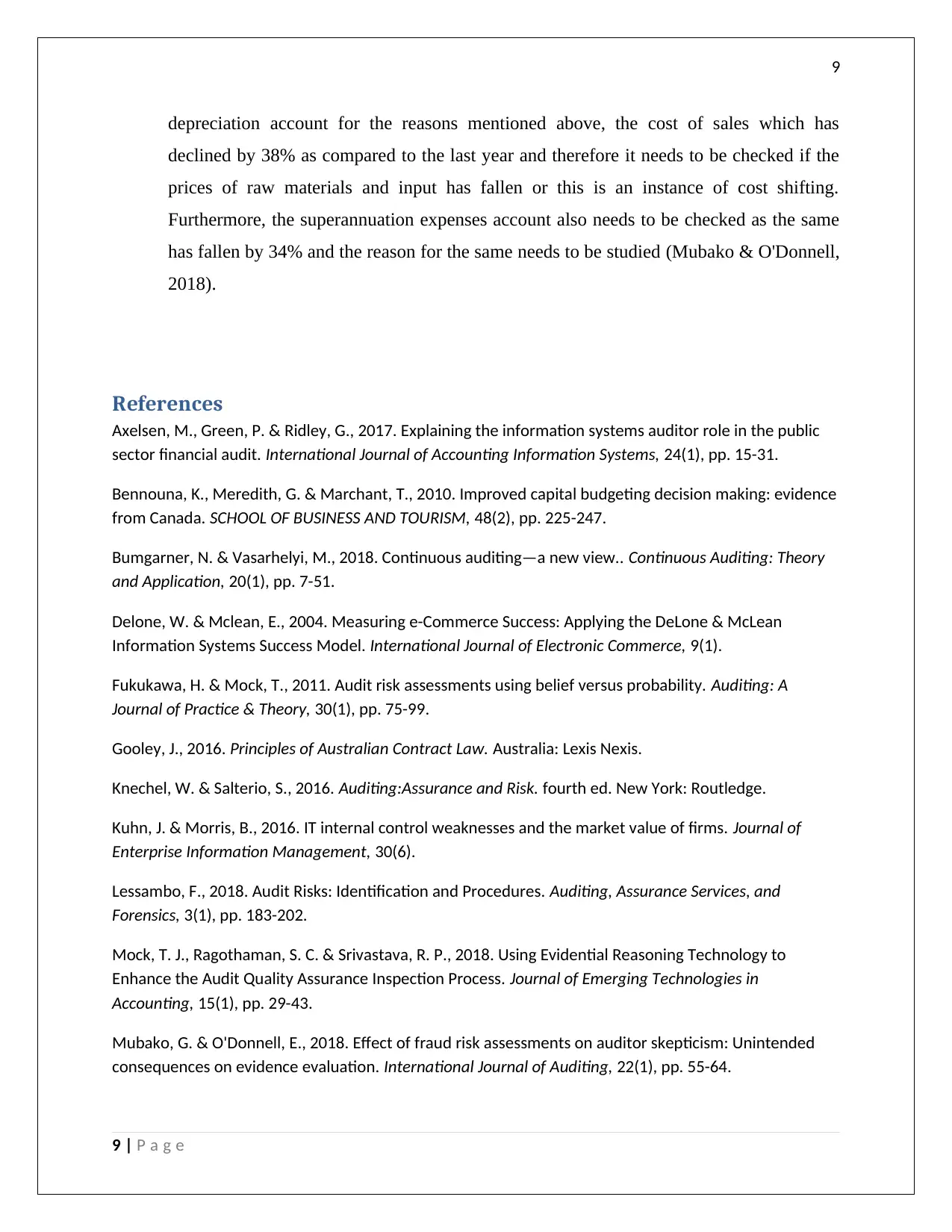
9
depreciation account for the reasons mentioned above, the cost of sales which has
declined by 38% as compared to the last year and therefore it needs to be checked if the
prices of raw materials and input has fallen or this is an instance of cost shifting.
Furthermore, the superannuation expenses account also needs to be checked as the same
has fallen by 34% and the reason for the same needs to be studied (Mubako & O'Donnell,
2018).
References
Axelsen, M., Green, P. & Ridley, G., 2017. Explaining the information systems auditor role in the public
sector financial audit. International Journal of Accounting Information Systems, 24(1), pp. 15-31.
Bennouna, K., Meredith, G. & Marchant, T., 2010. Improved capital budgeting decision making: evidence
from Canada. SCHOOL OF BUSINESS AND TOURISM, 48(2), pp. 225-247.
Bumgarner, N. & Vasarhelyi, M., 2018. Continuous auditing—a new view.. Continuous Auditing: Theory
and Application, 20(1), pp. 7-51.
Delone, W. & Mclean, E., 2004. Measuring e-Commerce Success: Applying the DeLone & McLean
Information Systems Success Model. International Journal of Electronic Commerce, 9(1).
Fukukawa, H. & Mock, T., 2011. Audit risk assessments using belief versus probability. Auditing: A
Journal of Practice & Theory, 30(1), pp. 75-99.
Gooley, J., 2016. Principles of Australian Contract Law. Australia: Lexis Nexis.
Knechel, W. & Salterio, S., 2016. Auditing:Assurance and Risk. fourth ed. New York: Routledge.
Kuhn, J. & Morris, B., 2016. IT internal control weaknesses and the market value of firms. Journal of
Enterprise Information Management, 30(6).
Lessambo, F., 2018. Audit Risks: Identification and Procedures. Auditing, Assurance Services, and
Forensics, 3(1), pp. 183-202.
Mock, T. J., Ragothaman, S. C. & Srivastava, R. P., 2018. Using Evidential Reasoning Technology to
Enhance the Audit Quality Assurance Inspection Process. Journal of Emerging Technologies in
Accounting, 15(1), pp. 29-43.
Mubako, G. & O'Donnell, E., 2018. Effect of fraud risk assessments on auditor skepticism: Unintended
consequences on evidence evaluation. International Journal of Auditing, 22(1), pp. 55-64.
9 | P a g e
depreciation account for the reasons mentioned above, the cost of sales which has
declined by 38% as compared to the last year and therefore it needs to be checked if the
prices of raw materials and input has fallen or this is an instance of cost shifting.
Furthermore, the superannuation expenses account also needs to be checked as the same
has fallen by 34% and the reason for the same needs to be studied (Mubako & O'Donnell,
2018).
References
Axelsen, M., Green, P. & Ridley, G., 2017. Explaining the information systems auditor role in the public
sector financial audit. International Journal of Accounting Information Systems, 24(1), pp. 15-31.
Bennouna, K., Meredith, G. & Marchant, T., 2010. Improved capital budgeting decision making: evidence
from Canada. SCHOOL OF BUSINESS AND TOURISM, 48(2), pp. 225-247.
Bumgarner, N. & Vasarhelyi, M., 2018. Continuous auditing—a new view.. Continuous Auditing: Theory
and Application, 20(1), pp. 7-51.
Delone, W. & Mclean, E., 2004. Measuring e-Commerce Success: Applying the DeLone & McLean
Information Systems Success Model. International Journal of Electronic Commerce, 9(1).
Fukukawa, H. & Mock, T., 2011. Audit risk assessments using belief versus probability. Auditing: A
Journal of Practice & Theory, 30(1), pp. 75-99.
Gooley, J., 2016. Principles of Australian Contract Law. Australia: Lexis Nexis.
Knechel, W. & Salterio, S., 2016. Auditing:Assurance and Risk. fourth ed. New York: Routledge.
Kuhn, J. & Morris, B., 2016. IT internal control weaknesses and the market value of firms. Journal of
Enterprise Information Management, 30(6).
Lessambo, F., 2018. Audit Risks: Identification and Procedures. Auditing, Assurance Services, and
Forensics, 3(1), pp. 183-202.
Mock, T. J., Ragothaman, S. C. & Srivastava, R. P., 2018. Using Evidential Reasoning Technology to
Enhance the Audit Quality Assurance Inspection Process. Journal of Emerging Technologies in
Accounting, 15(1), pp. 29-43.
Mubako, G. & O'Donnell, E., 2018. Effect of fraud risk assessments on auditor skepticism: Unintended
consequences on evidence evaluation. International Journal of Auditing, 22(1), pp. 55-64.
9 | P a g e
Paraphrase This Document
Need a fresh take? Get an instant paraphrase of this document with our AI Paraphraser
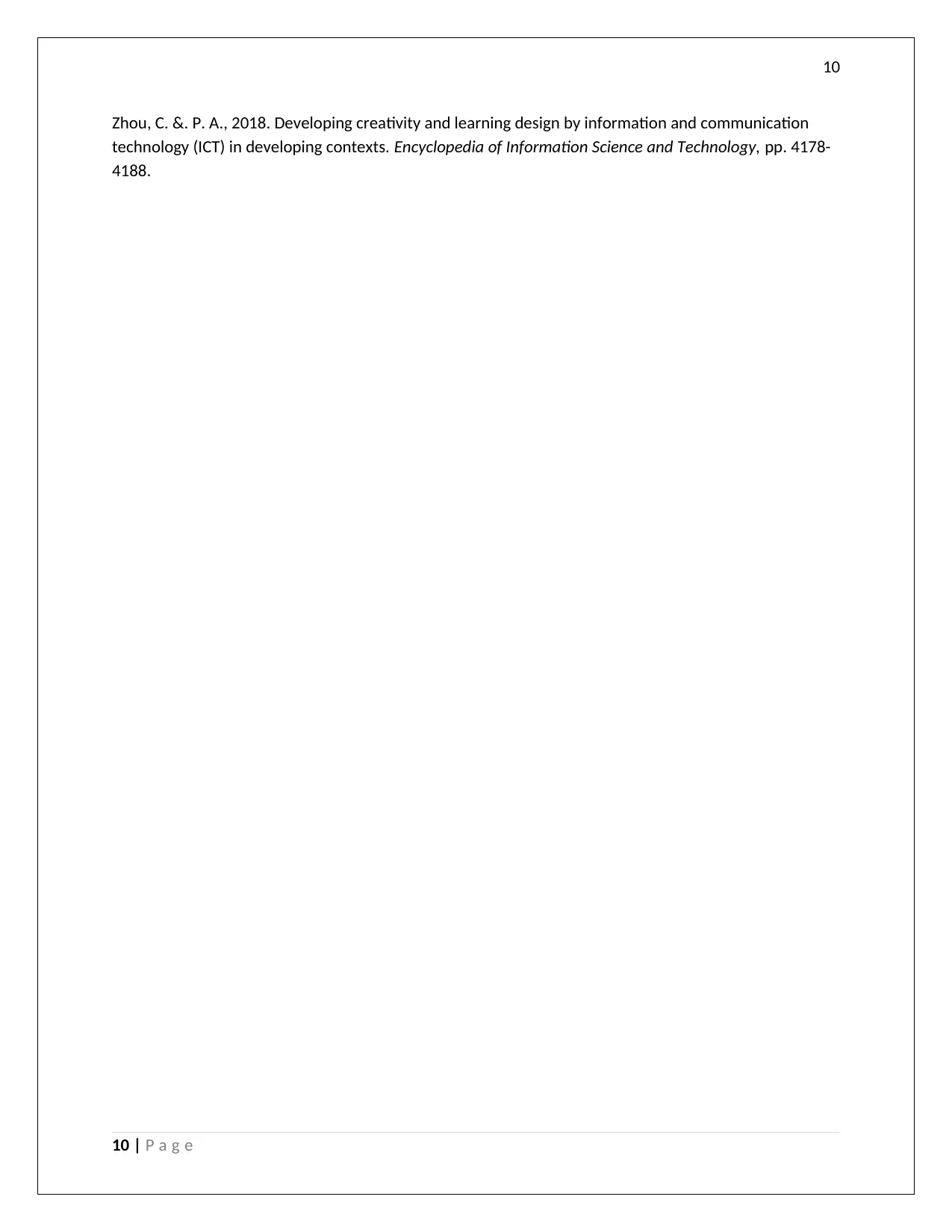
10
Zhou, C. &. P. A., 2018. Developing creativity and learning design by information and communication
technology (ICT) in developing contexts. Encyclopedia of Information Science and Technology, pp. 4178-
4188.
10 | P a g e
Zhou, C. &. P. A., 2018. Developing creativity and learning design by information and communication
technology (ICT) in developing contexts. Encyclopedia of Information Science and Technology, pp. 4178-
4188.
10 | P a g e
1 out of 11